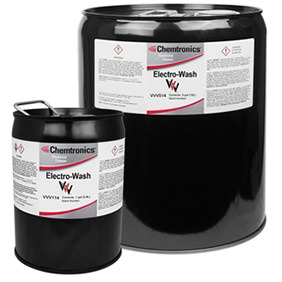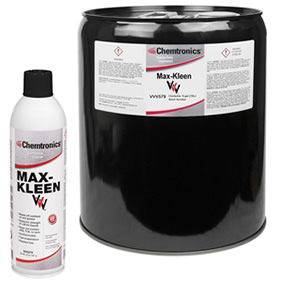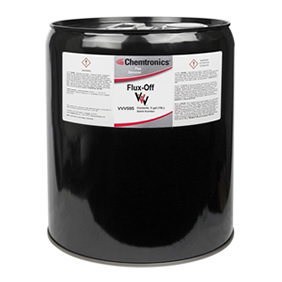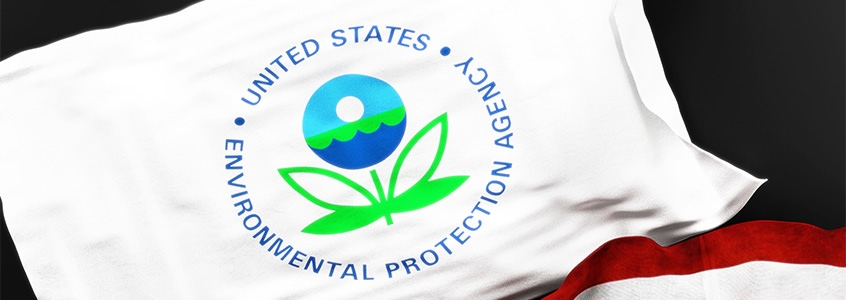The U.S. The Environmental Protection Agency (EPA) has recently introduced new regulations targeting 1-Bromopropane (1-BP or nPB), a solvent that is widely used in numerous industrial cleaning and degreasing applications. This initiative will pose challenges for companies that use 1-BP in their operations, so it’s important that alternative options are available to accommodate the growing need for safe chemical replacements.
Fortunately, Chemtronics offers safe and reliable 1-BP replacements in our product line. Our Tri-V degreasers are engineered to replace harmful chemicals and provide excellent degreasing.
What is 1-BP?
1-Bromopropane, abbreviated as 1-BP, is a solvent utilized for tasks such as cleaning and degreasing in various industries, including electronics, automotive, and dry cleaning. Despite its widespread use, increasing evidence suggests that 1-BP poses substantial health risks. Studies have linked exposure to 1-BP with serious conditions, including cancer and reproductive harm.
EPA 1-BP Ruling
The EPA's latest regulations impose rigorous controls on the use of 1-BP due to its harmful effects on health and the environment. These measures are informed by thorough research that highlights the chemical's potential to cause significant health problems, such as cancer and respiratory issues. The new rules require industries to cut down or completely phase out their use of 1-BP, encouraging the shift to safer alternatives.
What This Means
Businesses that rely on 1-BP will need to quickly adapt to meet these new regulatory requirements. This may involve seeking alternative solvents or altering existing cleaning procedures. The regulations mark a step towards stricter chemical safety practices and will bring both challenges and opportunities to the affected sectors.
Chemtronics’ Reliable Alternatives



Electro-Wash Tri-V, Max-Kleen Tri-V, and Flux-Off Tri-V
At Chemtronics, we offer the ultimate nPB replacements. Our Electro-Wash, Max-Kleen, and Flux-Off Tri-V degreasers are much safer than 1-BP, offering powerful cleaning for oils, greases, silicones, refrigerant oils, fluxes, adhesives, and other industrial contaminants.
Benefits of Electro-Wash:
- Does not contain n-propyl bromide, trichloroethylene, or perchloroethylene
- Nonflammable, can be used on energized equipment
- Penetrates to clean hard to reach areas
- Evaporates quickly and leaves no residues, minimizes down time
- Stabilized for metals such as aluminum, magnesium, titanium, and brass
- Non-corrosive, safe for sensitive metals
- NSF Registered - Nonfood Compounds / Code K1 and K2
Benefits of Max-Kleen:
- Does not contain n-propyl bromide, trichloroethylene, perchloroethylene, HAP’s, or any ozone depleting compounds
- Quickly removes all types of tough soils including oxidized oil and grease
- Best product for electronic applications
- Dielectric strength of >30 kV (liquid)
- Full azeotrope
- Nonflammable, no flash point
- Stabilized for metals such as aluminum, magnesium, titanium, and brass
- Non-corrosive, safe for sensitive metals
- Leaves no residue
- NSF Registered - Nonfood Compounds / Code K1 and K2
Benefits of Flux-Off:
- Nonflammable, can be used on energized equipment
- Powerful cleaning agent to remove R, RA, RMA, and synthetic fluxes
- Removes encrusted fluxes and white residues
- Penetrates to clean hard to reach areas
- Evaporates quickly and leaves no residues, minimizes down time
- Does not contain n-propyl bromide, trichloroethylene, or perchloroethylene
- Stabilized for metals such as aluminum, magnesium, titanium, and brass
- Non-corrosive, safe for sensitive metals
Reach out to us at Chemtronics to learn more about our safe nPB replacements!
Full Statement from our Regulatory Consultant:
EPA has published the proposed rule under the Toxic Substances Control Act (TSCA) for the solvent 1-bromopropane (1-BP). Exposure to this chemical can cause serious health effects such as skin, lung, and intestinal cancer; damage to the liver, kidneys, and nervous system; and effects on the reproductive systems that lead to reduced fertility. If finalized, the rule would prohibit all but one consumer use of 1-BP, as well as some workplace uses. 1-BP is a solvent that is widely used in cleaning and degreasing operations, spray adhesives, and dry cleaning. 1-BP is also used in insulation for building and construction materials and in the manufacture of other chemicals. Consumer uses of 1-BP include aerosol degreasers, spot cleaners, stain removers, and insulation.
EPA is proposing to protect the public from exposure to 1-BP by banning all consumer uses of this chemical except in insulation (because EPA determined that this use did not contribute to the unreasonable risk to people). The ban on consumer uses would begin to go into effect within 6 months after the final rule is published and would come fully into force within 15 months.
EPA is also proposing to ban some industrial and commercial uses of 1-BP for which EPA analysis identified safer alternatives. The ban on industrial and commercial uses would begin to go into effect 6 months after the final rule is published and would come fully into effect within 18 months. The industrial and commercial uses to be prohibited include:
- Dry cleaning, spot cleaning, and stain removers.
- Adhesives and sealants.
- Coin and scissor cleaners.
- Automotive care products used as engine degreasers, brake cleaners, and refrigerant flushes.
- Anti-adhesive agents used for mold cleaning and release products.
- Functional fluids used as refrigerants or cutting oils.
- Arts, crafts, and hobby materials.
The proposed rule would also require worker protections for several industrial and commercial uses of 1-BP that would continue but which EPA has determined contribute to the unreasonable risk to human health that must be addressed, including its use in vapor and aerosol degreasing, electronics, and electronic and metal products. To continue these uses, non-Federal workplaces would need to implement a Workplace Chemical Protection Program, including an exposure limit (0.05 ppm), within 12 months. EPA is also proposing to require the use of chemical-resistant gloves within 6 months for some uses for non-Federal workplaces, including manufacturing, processing (which includes recycling) and disposal, to protect workers from exposures to 1-BP through the skin. Federal agencies (and Federal contractors acting for or on behalf of the Federal Government) would be required to implement a Workplace Chemical Protection Program and use chemical-resistant gloves within 3 years. Many workplaces already employ stringent controls to reduce exposures to 1-BP. For some workplaces, such as those using 1-BP in vapor degreasing, these existing controls may already sufficiently reduce exposure to meet the inhalation exposure concentration limit proposed in this rulemaking.
The proposed rule is attached and available at:
https://www.regulations.gov/docket/EPA-HQ-OPPT-2020-0471/document
The Economic Analysis is available here:
https://www.regulations.gov/document/EPA-HQ-OPPT-2020-0471-0114
The Alternatives Assessment is available here:
https://www.regulations.gov/document/EPA-HQ-OPPT-2020-0471-0063
Areas of particular importance include information on whether the implementation timelines are viable and if the proposed ECEL of 0.05 ppm is workable.
Comments will be due 45 days after the proposal is published or September 23rd.
CONTACT US TODAY
Haga una pregunta técnica
Manténgase actualizado sobre noticias, productos, videos y más de Chemtronics.

